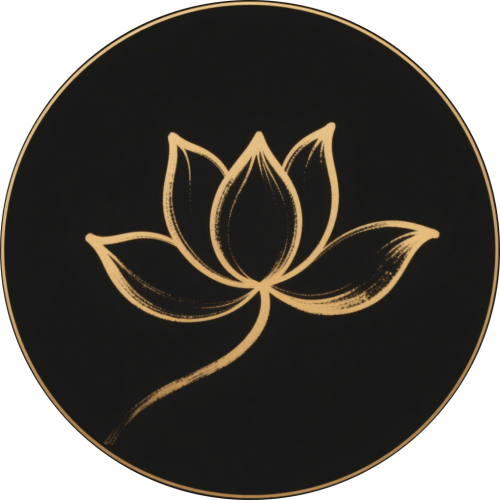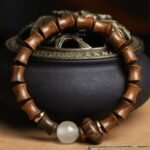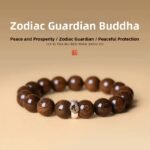welcome to Zendaosanctum | Free shipping on orders over $69.99 | 30-day money-back guarantee
Buddhist Mala Beads Explained: Power, Use, and Symbolism
Have you ever been intrigued by those exquisite strings of beads donned by monks and spiritual seekers? A Buddhist Mala is far more than mere adornment. What mysteries do these sacred prayer beads hold? How can they elevate your meditation practice and spiritual voyage?
For over 2,500 years, these ancient instruments have steered countless souls towards enlightenment. From the vibrant monasteries of Tibet to modern meditation hubs across the globe, the Buddhist Mala remains a potent ally for prayer, mindfulness, and spiritual advancement. Whether you’re a seasoned practitioner or a curious novice, grasping the profound symbolism and practical uses of these sacred beads can profoundly enrich your spiritual practice.
This article delves into:
- What is a Buddhist Mala?
- Historical Origins and Sacred Stories
- Materials and Their Spiritual Significance
- The Power of 108 Beads
- How to Use Buddhist Mala Beads
- Symbolism and Spiritual Meaning
- Different Types of Buddhist Malas
- Caring for Your Buddhist Mala
- Modern Applications and Benefits
- Conclusion
- FAQs
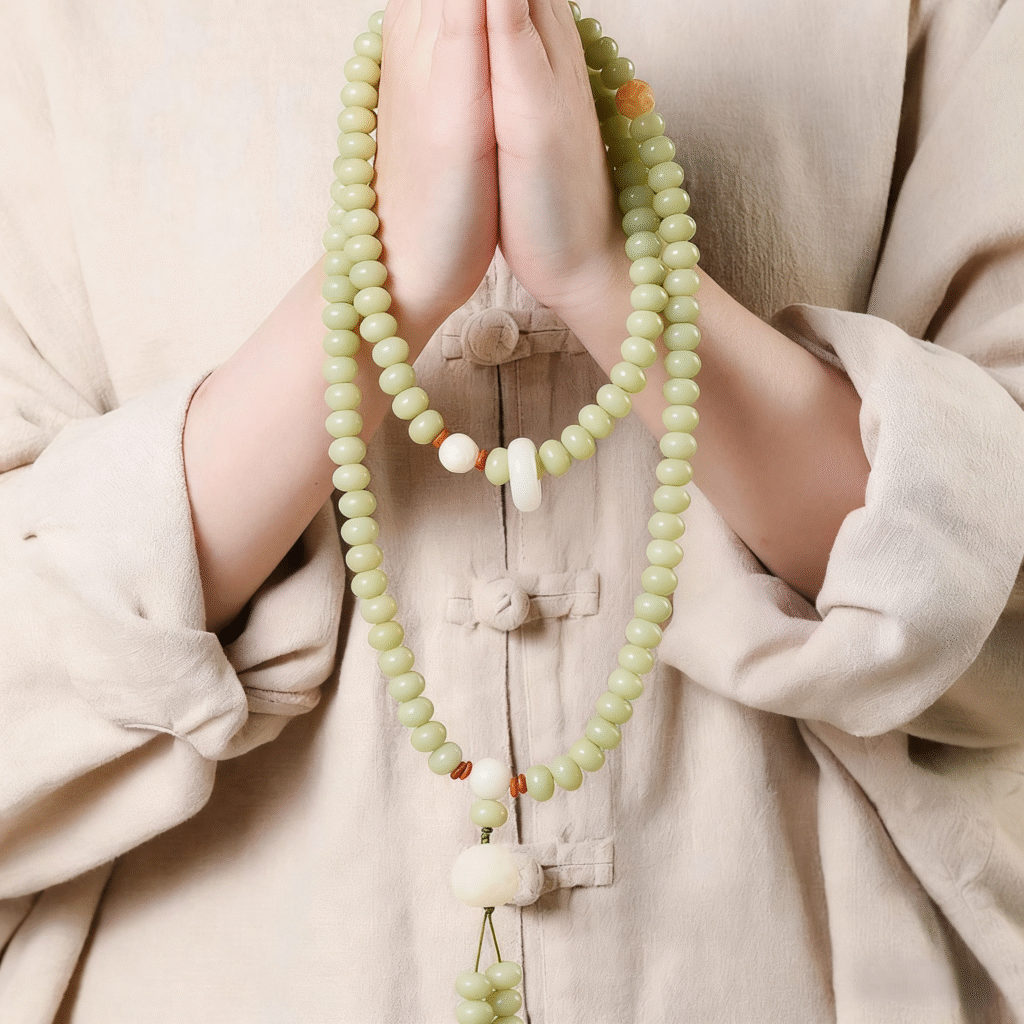
What is a Buddhist Mala?
A Buddhist Mala is a string of prayer beads mainly used for counting mantras, prayers, and breaths during meditation. The term “mala” originates from Sanskrit, signifying “garland” or “rosary.” These sacred tools usually consist of 108 beads, though shorter versions with 54, 27, or 21 beads also exist.
Traditional Structure and Design
The classic Buddhist Mala adheres to specific construction rules. Each strand starts with a larger bead known as the “guru bead” or “meru bead.” This special bead embodies the teacher-student relationship and acts as the starting and ending point for prayer cycles.
Every 27 beads, you’ll often find spacer beads. These markers assist practitioners in tracking their progress during lengthy meditation sessions. Some malas have a tassel at the end, symbolizing the connection to the divine and the unity of all beings.
Sacred Numbers in Mala Construction
The number 108 holds deep significance in Buddhist tradition. This sacred number appears throughout Hindu and Buddhist cosmology, representing the mathematical perfection of the universe. When using a Buddhist Mala, practitioners complete 108 repetitions of their chosen mantra or prayer.
Historical Origins and Sacred Stories
Buddhism’s rich history is closely intertwined with mala bead traditions. Legend has it that Buddha’s disciple, King Vaidurya, received divine guidance on creating prayer beads. The king was instructed to string together 108 seeds from the Bodhi tree—the same species under which Buddha attained enlightenment.
Ancient Monastery Practices
Tibetan monasteries preserve ancient Buddhist Mala traditions that date back centuries. Monks would craft their own prayer beads using locally sourced materials. Each bead carried intentions and prayers, making every mala unique and personally meaningful.
These monastery traditions spread across Asia, adapting to local customs and available materials. Despite regional differences, the core purpose remained unchanged: facilitating a deeper spiritual connection through repetitive prayer and meditation.

Cultural Transmission Across Continents
As Buddhism spread from India to Tibet, China, Japan, and Southeast Asia, Buddhist Mala designs evolved. Each culture contributed unique materials, decorative elements, and spiritual interpretations while keeping the essential 108-bead structure.
Materials and Their Spiritual Significance
Different materials used in Buddhist Mala construction possess distinct energetic properties and symbolic meanings. Understanding these materials helps practitioners select beads that align with their spiritual goals and personal preferences.
Bodhi Seeds: The Original Sacred Bead
Bodhi seeds are the most traditional material for crafting authentic Buddhist Mala beads. These seeds come from the sacred Bodhi tree, representing wisdom, enlightenment, and spiritual awakening. Many practitioners favor bodhi seed malas for their direct connection to Buddha’s enlightenment experience.
The natural texture and earthy look of bodhi seeds provide tactile feedback during meditation. As practitioners use their mala regularly, the seeds develop a smooth, polished surface from repeated handling.
Amazonite: Stone of Courage and Truth
Amazonite brings calming energy to Buddhist Mala practice. This beautiful blue-green stone promotes honest communication and emotional balance. Practitioners often choose amazonite malas when working on self-expression and inner truth.
The stone’s soothing color reminds users of peaceful waters and clear skies. During meditation, amazonite encourages practitioners to speak their truth with compassion and clarity.
Lava Rock: Grounding Earth Energy
Lava rock malas connect practitioners to Earth’s primal energy. These porous stones form from volcanic activity, representing transformation and rebirth. A Buddhist Mala made from lava rock helps ground scattered energy and promotes emotional stability. The rough texture of lava rock provides excellent tactile feedback during meditation.
The Power of 108 Beads
Why does every traditional Buddhist Mala have exactly 108 beads? This sacred number appears throughout Eastern spirituality and astronomy, carrying deep mathematical and cosmic significance.
Mathematical Perfection
The number 108 represents mathematical harmony in multiple ways. It equals 1 raised to the first power, 2 to the second power, and 3 to the third power (1×2²×3³). This calculation creates perfect mathematical balance, reflecting universal order and cosmic harmony.
Additionally, 108 divides evenly by many numbers including 2, 3, 4, 6, 9, 12, 18, 27, 36, and 54. This divisibility makes it practical for various meditation practices and prayer cycles.
Astronomical Connections
Ancient astronomers discovered fascinating relationships involving 108. The distance between Earth and the Sun equals approximately 108 times the Sun’s diameter. Similarly, the distance between Earth and the Moon equals roughly 108 times the Moon’s diameter.
These cosmic proportions suggest that Buddhist Mala beads connect practitioners to universal rhythms and celestial movements during meditation and prayer.
How to Use Buddhist Mala Beads
Proper Buddhist Mala usage follows specific techniques that maximize spiritual benefits and maintain traditional respect for these sacred tools.
Basic Meditation Technique
Begin by holding your Buddhist Mala in your right hand, draping it over your middle finger. Use your thumb to move each bead toward you while reciting your chosen mantra or prayer. Never use your index finger, as this digit represents ego in Buddhist tradition.
Start at the guru bead and work your way around the entire strand. When you complete one full cycle of 108, you’ve finished one “round” of practice. For longer sessions, simply reverse direction and continue without crossing over the guru bead.
Breath Counting Method
Some practitioners use their Buddhist Mala for breath awareness meditation. Instead of reciting mantras, count each inhale and exhale while moving through the beads. This technique develops mindfulness and concentration while maintaining the mala’s traditional structure.
Each bead represents one complete breath cycle. This method particularly benefits beginners who find mantra recitation challenging or distracting.
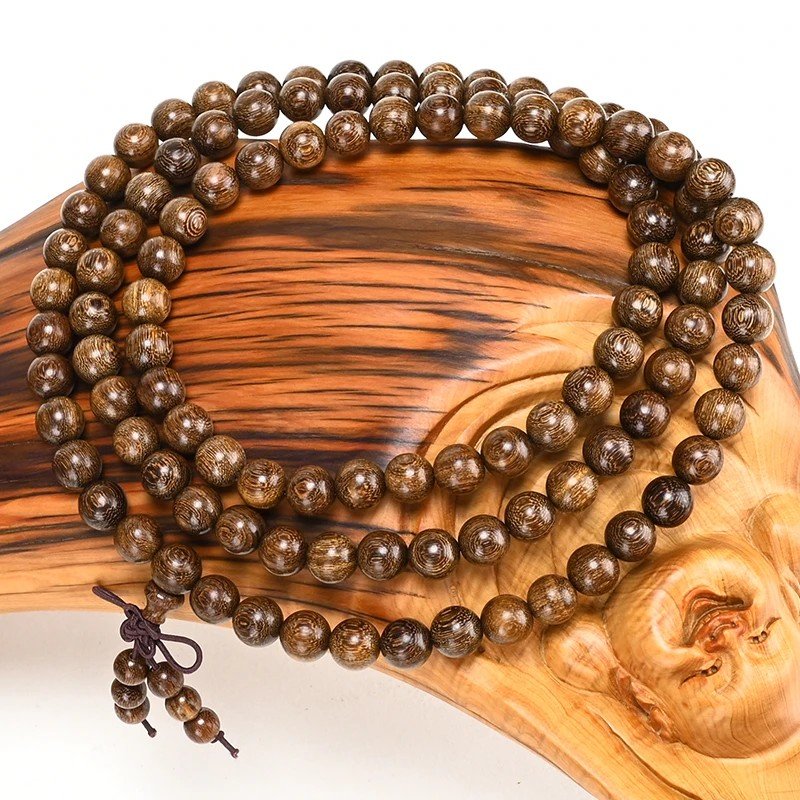
Setting Intentions
Before beginning any Buddhist Mala practice, set clear intentions for your session. Hold the guru bead and silently dedicate your practice to specific goals: cultivating compassion, developing wisdom, or sending loving-kindness to others.
Clear intentions transform mechanical bead counting into meaningful spiritual practice. Each repetition carries your focused energy toward your chosen spiritual goal.
Symbolism and Spiritual Meaning
Every aspect of a Buddhist Mala carries profound symbolic meaning that enriches meditation practice and spiritual understanding.
The Guru Bead’s Significance
The guru bead represents the teacher-student relationship fundamental to Buddhist learning. This larger bead honors all teachers who transmit wisdom and guidance. When practitioners touch the guru bead, they connect with this lineage of spiritual knowledge.
Some traditions view the guru bead as representing Buddha himself. Others see it as honoring one’s personal spiritual teacher or inner wisdom. Regardless of interpretation, this special bead marks the beginning and end of each prayer cycle.
Circle of Completion
The circular structure of a Buddhist Mala symbolizes the endless cycle of life, death, and rebirth. This continuous loop reminds practitioners that spiritual development never truly ends. Each completion of the mala represents one turn of the eternal wheel of dharma.
Moving through the beads clockwise follows the natural direction of universal energy. This movement aligns practitioners with cosmic rhythms and traditional spiritual practices.
Unity in Repetition
Repetitive use of Buddhist Mala beads creates meditative states that transcend ordinary consciousness. Each repeated mantra or prayer builds spiritual momentum, gradually dissolving the ego’s mental chatter and revealing deeper awareness.
This repetitive practice mirrors natural rhythms: heartbeats, breathing, ocean waves, and seasonal cycles. Through repetition, practitioners align their personal energy with universal patterns.
Different Types of Buddhist Malas
Various Buddhist Mala styles serve different spiritual purposes and traditions within Buddhist practice.
Prayer Malas for Devotion
Devotional malas focus on developing faith and connection with Buddhist deities or teachings. Practitioners use these Buddhist Mala beads while reciting prayers dedicated to Buddha, Tara, or other enlightened beings.
These malas often feature materials and colors associated with specific deities. For example, white beads connect with White Tara’s compassionate energy, while red stones align with Amitabha Buddha’s infinite light.
Meditation Malas for Mindfulness
Meditation-focused Buddhist Mala designs emphasize simplicity and comfort for extended sitting practice. These malas typically use smooth, evenly sized beads that feel pleasant during long sessions.
Materials like sandalwood or smooth stones work well for meditation malas. The consistent texture helps maintain focus without creating distracting sensations.
Wrist Malas for Daily Practice
Shorter wrist malas containing 21 or 27 beads offer portable options for busy practitioners. These compact Buddhist Mala versions fit easily around the wrist, providing constant reminders of spiritual intentions throughout daily activities.
Despite their smaller size, wrist malas maintain traditional proportions and symbolic meanings. They’re perfect for brief meditation sessions during work breaks or travel.
Caring for Your Buddhist Mala
Proper care ensures your Buddhist Mala remains energetically clear and physically durable for years of spiritual practice.
Energetic Cleansing Methods
Regular energetic cleansing removes accumulated negative energy from your mala beads. Simple methods include placing your Buddhist Mala in moonlight overnight, smudging with sage or incense, or using sound vibrations from singing bowls.
Physical Maintenance
Keep your Buddhist Mala clean by gently wiping beads with a soft, dry cloth after use. Avoid exposing delicate materials like seeds or certain stones to excessive moisture or direct sunlight.
Store your mala in a dedicated pouch or on a special altar when not in use. This practice maintains the beads’ sacred energy and prevents physical damage from everyday wear.
Restringing and Repairs
Over time, even well-maintained Buddhist Mala strands may require restringing. This maintenance offers opportunities to refresh your spiritual practice and reconnect with your mala’s purpose.
Many practitioners view restringing as a meditative practice itself. Threading each bead mindfully while setting new intentions can revitalize both the physical mala and your spiritual commitment.
Modern Applications and Benefits
Contemporary practitioners discover numerous ways to integrate Buddhist Mala beads into modern spiritual and wellness practices.
Stress Reduction Techniques
Using a Buddhist Mala for stress relief doesn’t require complex Buddhist knowledge. Simply holding and moving through the beads while taking deep breaths can calm anxiety and center scattered thoughts.
The tactile sensation of smooth beads provides grounding during overwhelming moments. This physical anchor helps bring attention back to the present moment, naturally reducing stress and promoting emotional balance.
Mindfulness Development
Regular Buddhist Mala practice strengthens mindfulness skills that benefit all areas of life. The focused attention required for bead counting and mantra recitation trains the mind to stay present and aware.
These mindfulness skills transfer to daily activities, improving concentration at work, enhancing relationships, and increasing overall life satisfaction.
Sleep and Relaxation
Many practitioners use their Buddhist Mala as a tool for bedtime meditation and relaxation. Gently moving the beads in sync with slow, mindful breathing helps calm the nervous system and ease the mind into a restful state.
This simple nightly mala meditation often proves more effective than digital meditation apps. Unlike screens, the physical mala offers a tactile point of focus, promoting deep presence without any artificial light or distraction.
Conclusion
The Buddhist Mala is far more than decorative jewelry or simple prayer beads. These sacred tools offer profound pathways to spiritual growth, emotional balance, and mindful living. Whether crafted from traditional bodhi seeds, calming amazonite, or grounding lava rock, each mala carries the potential to transform your meditation practice and daily spiritual awareness.
Through understanding proper usage, caring maintenance, and deep symbolism, practitioners can unlock the full power of these ancient spiritual companions. As you explore the world of Buddhist prayer beads, may your journey be filled with insight and peace.
FAQs
What is mala in Buddhism?
A mala is a string of beads used to count mantras during meditation, aiding focus and spiritual practice.
Is it okay to wear mala beads?
Yes, wearing mala beads respectfully is common and helps remind you of mindfulness and spiritual intentions.
Why 108 mala beads in Buddhism?
The 108 beads represent sacred numbers symbolizing human passions or spiritual steps toward enlightenment.
How to choose your mala?
Choose a mala that resonates with you personally, considering materials, colors, and your spiritual needs.
